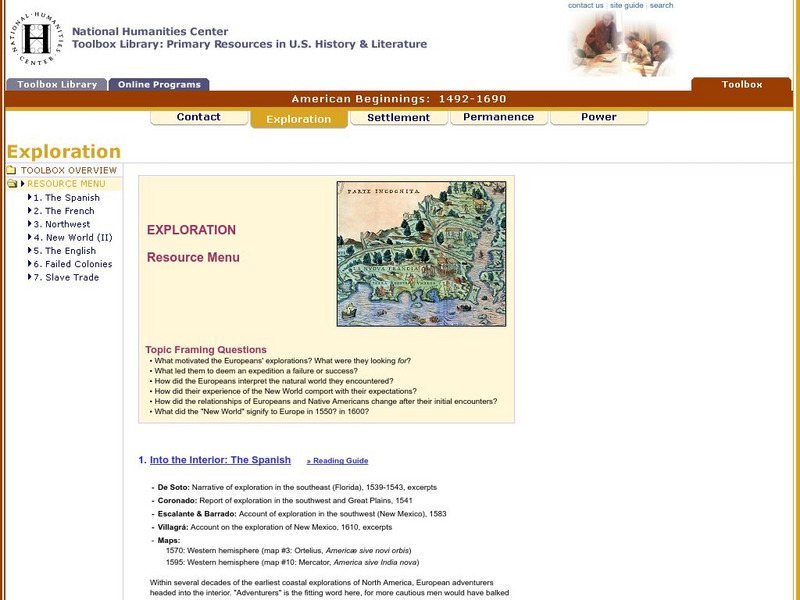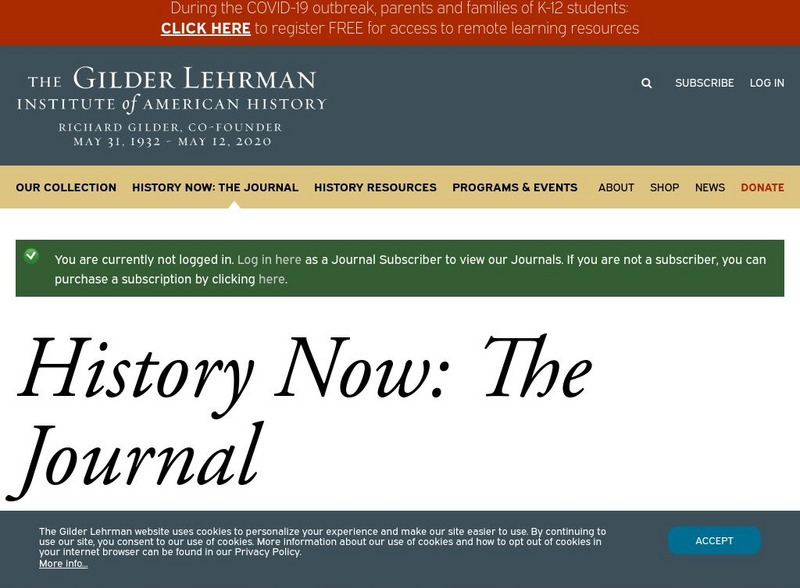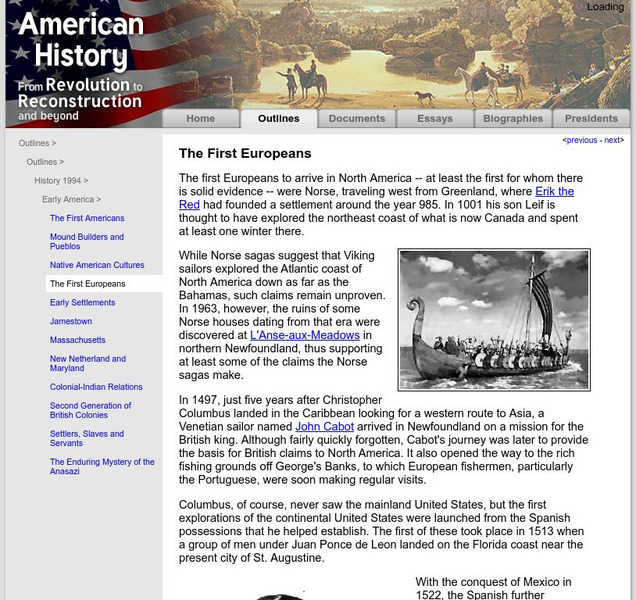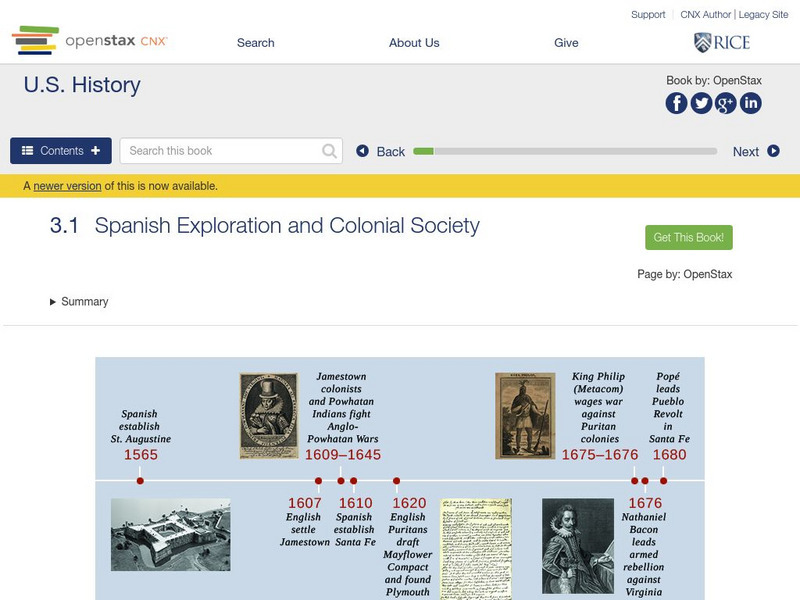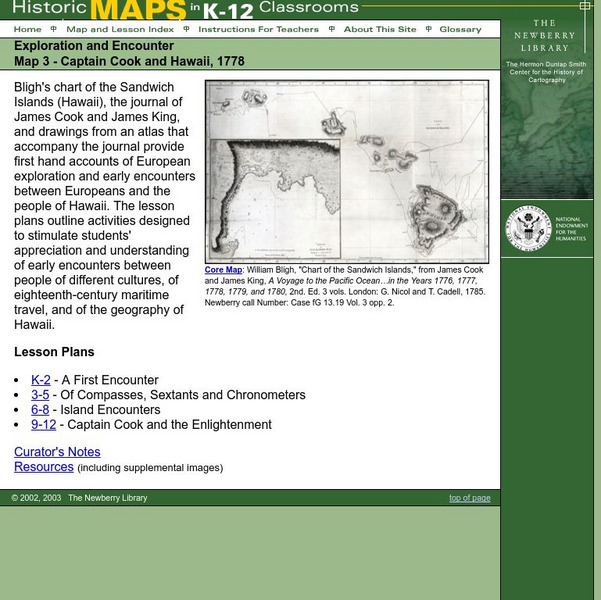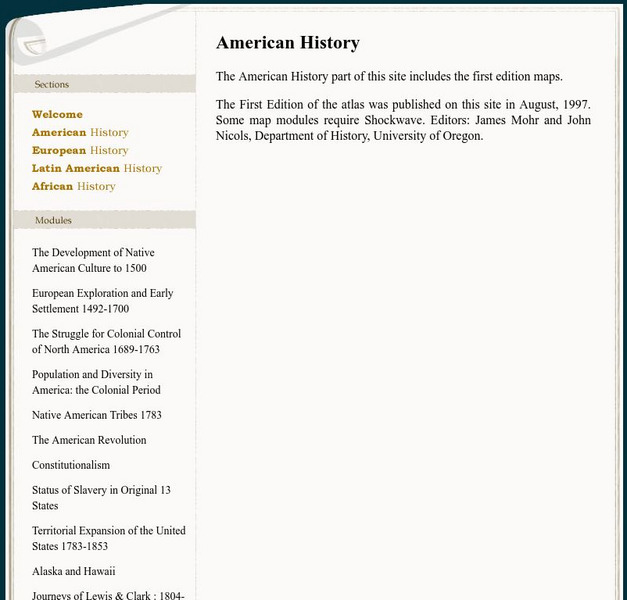National Humanities Center
National Humanities Center: Toolbox Library: Exploration, American Beginnings: 1492 1690
Thirty two primary sources-historical documents, literary texts, and visual images-that explore the expectations and the realities of European exploration of the New World.
Mariners' Museum and Park
Mariners' Museum: The Ages of Exploration: Age of Discovery
This Age of Discovery page presents naval artifacts and explorers of the 15th century to the early 17th century. It looks at European explorers who journeyed to North and South America, the search for the Northwest Passage, and...
Mariners' Museum and Park
Age of Exploration: Changing View of the World: The Development of Map Making
Read a summary of the history of map-making and the maps that were produced as a result of European exploration in the Americas. See examples of these maps and find out more about each one in this exhibit from the Mariners' Museum.
Gilder Lehrman Institute of American History
Gilder Lehrman Institute: Age of Exploration
[Free Registration/Login Required] Learn about the exploration of the Americas. Site includes primary source documents, videos, essays, and lesson plans to help students research the exploration of the new land.
PBS
Pbs Learning Media: Primary Source Set: Exploration of the Americas
This collection uses primary sources to explain the early exploration of the Americas.
Wisconsin Historical Society
American Journeys: Eyewitness Accounts Early American Exploration/settlement
A collaborative project of the Wisconsin Historical Society and National History Day, this site contains over 18,000 pages of primary source, eyewitness accounts of North American exploration starting with the Vikings.
University of California
Uc Santa Barbara: What Brought the Europeans to America?
Short essay addresses reasons that brought the Europeans to America. Covering many important points, he also provides compelling reasons and a map.
University of Calgary
European Voyages of Exploration: 15th & 16th Centuries
This award-winning website from the University of Calgary's History Department is both impressive and extensive. It focuses on Portuguese and Spanish expeditions of the 15th and 16th centuries (the sitemap provides a good outline of...
University of Groningen
American History: Outlines: The First Europeans
The first Europeans to arrive in North America -- at least the first for whom there is solid evidence -- were Norse, traveling west from Greenland, where Erik the Red had founded a settlement around the year 985. In 1001 his son Leif is...
University of Groningen
American History: Outlines: The First Europeans
The first Europeans to arrive in North America -- at least the first for whom there is solid evidence -- were Norse, traveling west from Greenland, where Erik the Red had founded a settlement around the year 985. In 1001 his son Leif is...
National Geographic
National Geographic: European Borders Through History
Lesson in which students use maps to explore how European political borders have changed over time. Maps after WWI, WWII and European Union provided for comparison.
Library of Congress
Loc: Discovery and Exploration
This American Memory site documents the discovery and exploration of the Americas with both manuscripts and published maps, many of which date from the European Age of Discovery. The site includes 22 map titles and descriptions, as well...
OpenStax
Open Stax: Colonial Societies 1500 1700: Spanish Exploration & Colonial Society
Examines the establishment of Spanish settlements in America, the differences between them, and the conflicts the Spanish had with other European interests and with the native peoples.
McGraw Hill
Mc Graw Hill Higher Education: Old World, New Worlds
This article from McGraw-Hill Higher Education discusses European exploration in the late 1400s and 1500s and its impact on English colonization hundreds of years later.
The Newberry Library
Newberry: Exploration and Encounter: Map 3, Captain Cook and Hawaii, 1778
Map and primary source information provide first-hand account of exploration and encounters between Europeans and Hawaiians. Includes lesson plans for k-12, links to reference material and supplemental resources, and curators notes.
State Library of North Carolina
N Cpedia: John W. Kinchelo, Iii: American Indians at European Contact
Native Americans inhabited the New World long before European explorers began establishing settlements on the land. This entry addresses the challenges the natives had to face upon Europe's arrival, trials in relationships, and how...
Other
Texas Bob: The First Europeans in Texas: 1528 1536
One of the first Europeans to penetrate the interior of Texas, read Alvar Nunez Cabeza de Vaca's account of his shipwreck and eventual return to the Spanish Court.
Alabama Learning Exchange
Alex: Exploring the Culture of Europe
In this technology-based lesson, students will create a slideshow presentation or a travel brochure to highlight attractions in a chosen country and the historical significance of each attraction. Students will present their created...
Annenberg Foundation
Annenberg Learner: Teaching Geography: European Union
Explore the European region and consider what makes a successful city and how effective is supranationalism? A video features Berlin and Amsterdam for urban development and then looks into the concept of supranationalism in the European...
University of Oregon
Mapping History: American History
Interactive and animated maps and timelines of historical events and time periods in American history from pre-European times until post-World War II.
Museum of Fine Arts, Boston
Museum of Fine Arts, Boston: European Paintings Collection Highlights
Explore a selection of the MFA's holdings of over 1,400 paintings from across Europe, featuring masterworks from the middle ages to the mid-twentieth century. Click on 'View All Works' to access the collection.
Metropolitan Museum of Art
Metropolitan Museum of Art: Eighteenth Century European Dress
Explore fashion from the 1700's with the slideshow. Includes a discussion of popular styles, textiles and silhouettes.
Smithsonian Institution
Smithsonian Libraries: The Art of African Exploration
The Art of African Exploration is a catalog of primary sources that documents the impressions of Europeans who traveled to Africa in the late eighteenth and nineteenth century to explore and conquer. View the work of expedition artists...
Khan Academy
Khan Academy: Motivation for European Conquest of the New World
God, gold, and glory motivated European nations to explore and create colonies in the New World. This article discusses the Crusades and how they influenced European colonization projects.
Other popular searches
- European Exploration Chart
- European Exploration Routes
- European Exploration Reasons
- European Exploration America
- Early European Explorations
- Age of European Exploration
- European Exploration in Texas
- European Exploration of Texas


